Analysis of Management Across Borders: A Comprehensive Report
VerifiedAdded on 2020/04/01
|15
|3724
|51
Report
AI Summary
This report provides a comprehensive analysis of management across borders, examining the challenges and opportunities that arise in a globalized business environment. The introduction highlights the increasing need for organizations to develop effective strategies for international operations. The report delves into the global context of management, discussing the impact of globalization, technological advancements, and the role of international governing bodies. It also explores cross-cultural diversity and its implications for management, emphasizing the importance of understanding cultural differences in communication, business practices, and employee relations. The report outlines the characteristics of successful cross-border managers, including emotional intelligence, tolerance for uncertainty, and the ability to balance local and global needs. Furthermore, it addresses the challenges of managing across borders, such as exposure to risks, human resource integration, and government policies. Finally, the report discusses the opportunities for cross-border operations, including access to new markets, resources, and product flexibility, concluding with strategies for cross-border operations.

Name 1
Management across borders
Student’s name
University
Management across borders
Student’s name
University
Paraphrase This Document
Need a fresh take? Get an instant paraphrase of this document with our AI Paraphraser
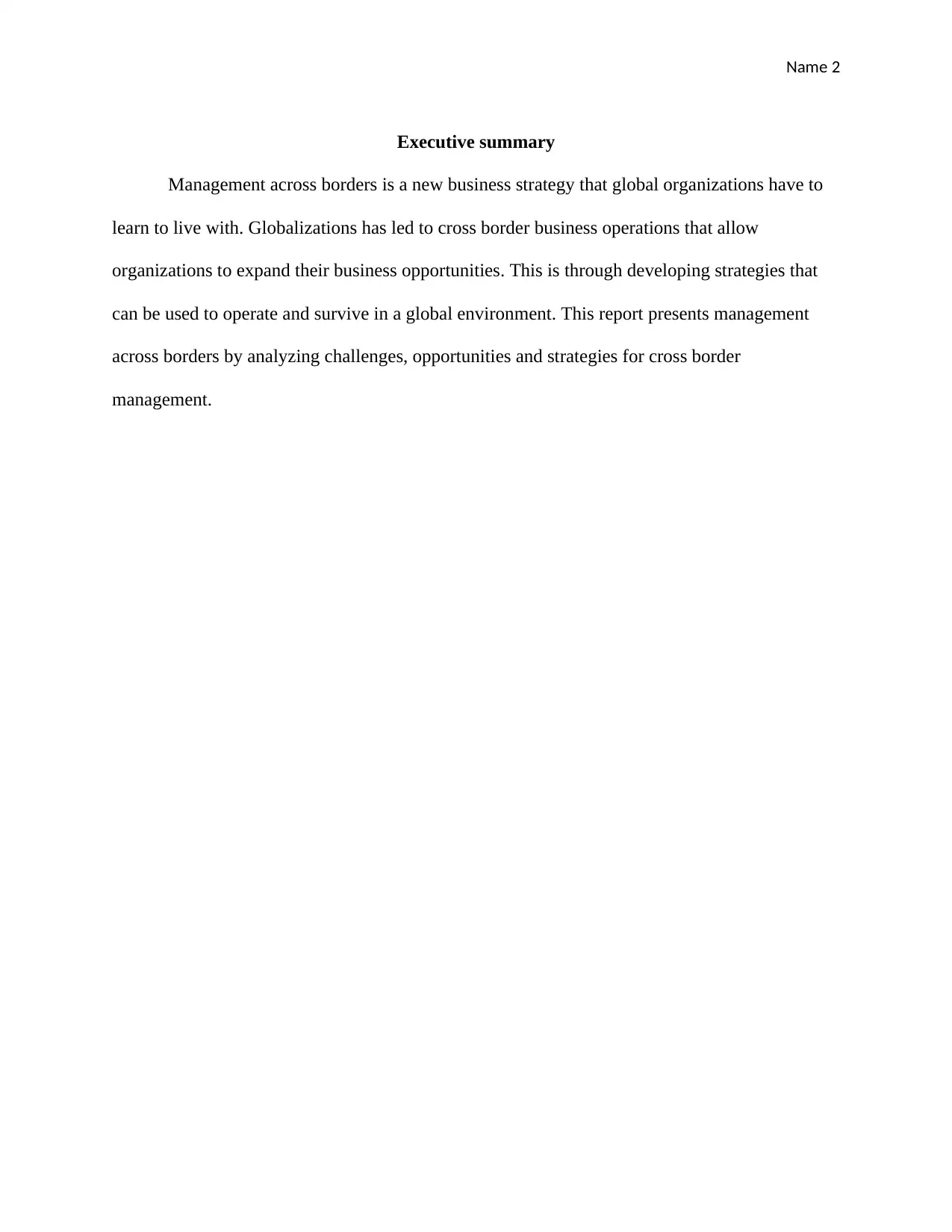
Name 2
Executive summary
Management across borders is a new business strategy that global organizations have to
learn to live with. Globalizations has led to cross border business operations that allow
organizations to expand their business opportunities. This is through developing strategies that
can be used to operate and survive in a global environment. This report presents management
across borders by analyzing challenges, opportunities and strategies for cross border
management.
Executive summary
Management across borders is a new business strategy that global organizations have to
learn to live with. Globalizations has led to cross border business operations that allow
organizations to expand their business opportunities. This is through developing strategies that
can be used to operate and survive in a global environment. This report presents management
across borders by analyzing challenges, opportunities and strategies for cross border
management.
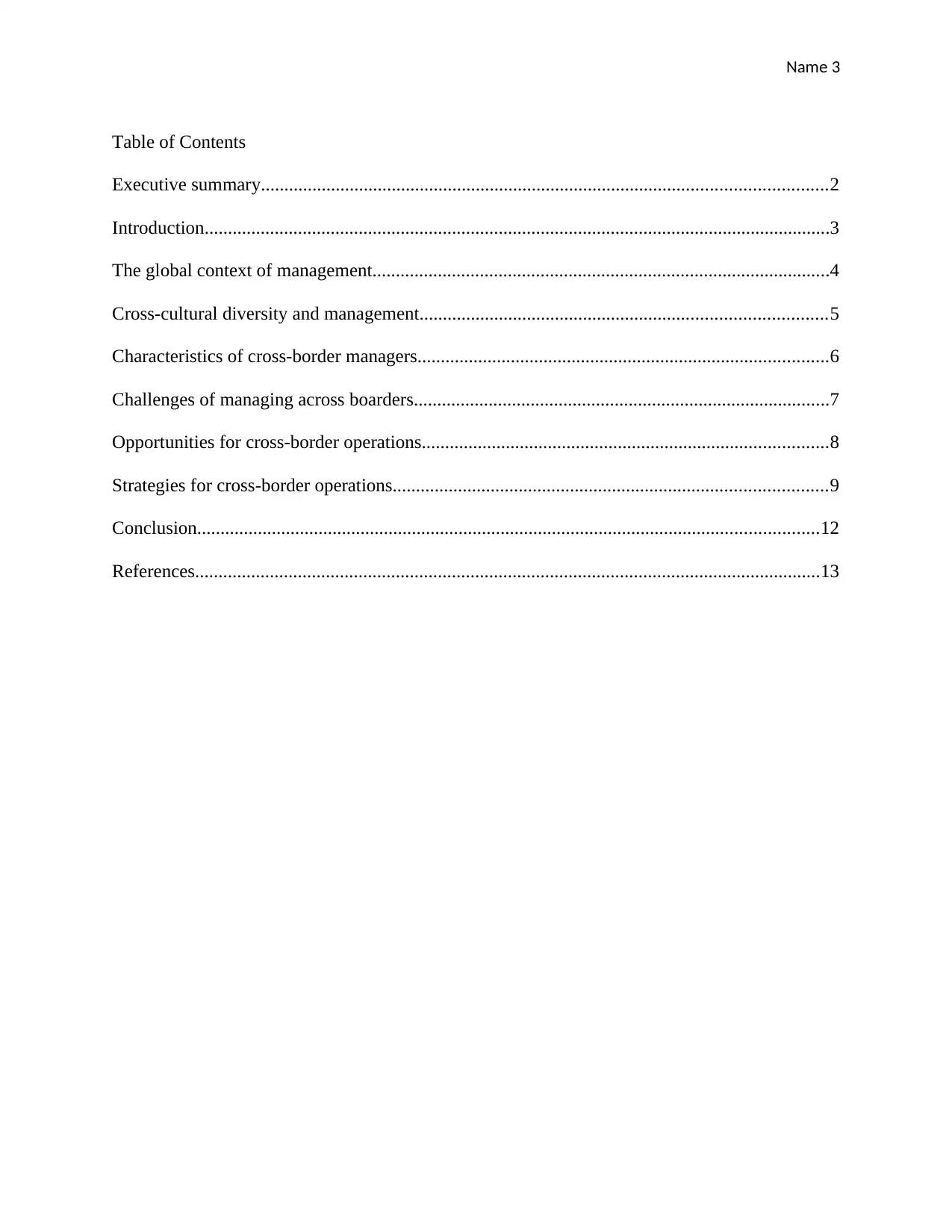
Name 3
Table of Contents
Executive summary.........................................................................................................................2
Introduction......................................................................................................................................3
The global context of management..................................................................................................4
Cross-cultural diversity and management.......................................................................................5
Characteristics of cross-border managers........................................................................................6
Challenges of managing across boarders.........................................................................................7
Opportunities for cross-border operations.......................................................................................8
Strategies for cross-border operations.............................................................................................9
Conclusion.....................................................................................................................................12
References......................................................................................................................................13
Table of Contents
Executive summary.........................................................................................................................2
Introduction......................................................................................................................................3
The global context of management..................................................................................................4
Cross-cultural diversity and management.......................................................................................5
Characteristics of cross-border managers........................................................................................6
Challenges of managing across boarders.........................................................................................7
Opportunities for cross-border operations.......................................................................................8
Strategies for cross-border operations.............................................................................................9
Conclusion.....................................................................................................................................12
References......................................................................................................................................13
⊘ This is a preview!⊘
Do you want full access?
Subscribe today to unlock all pages.

Trusted by 1+ million students worldwide
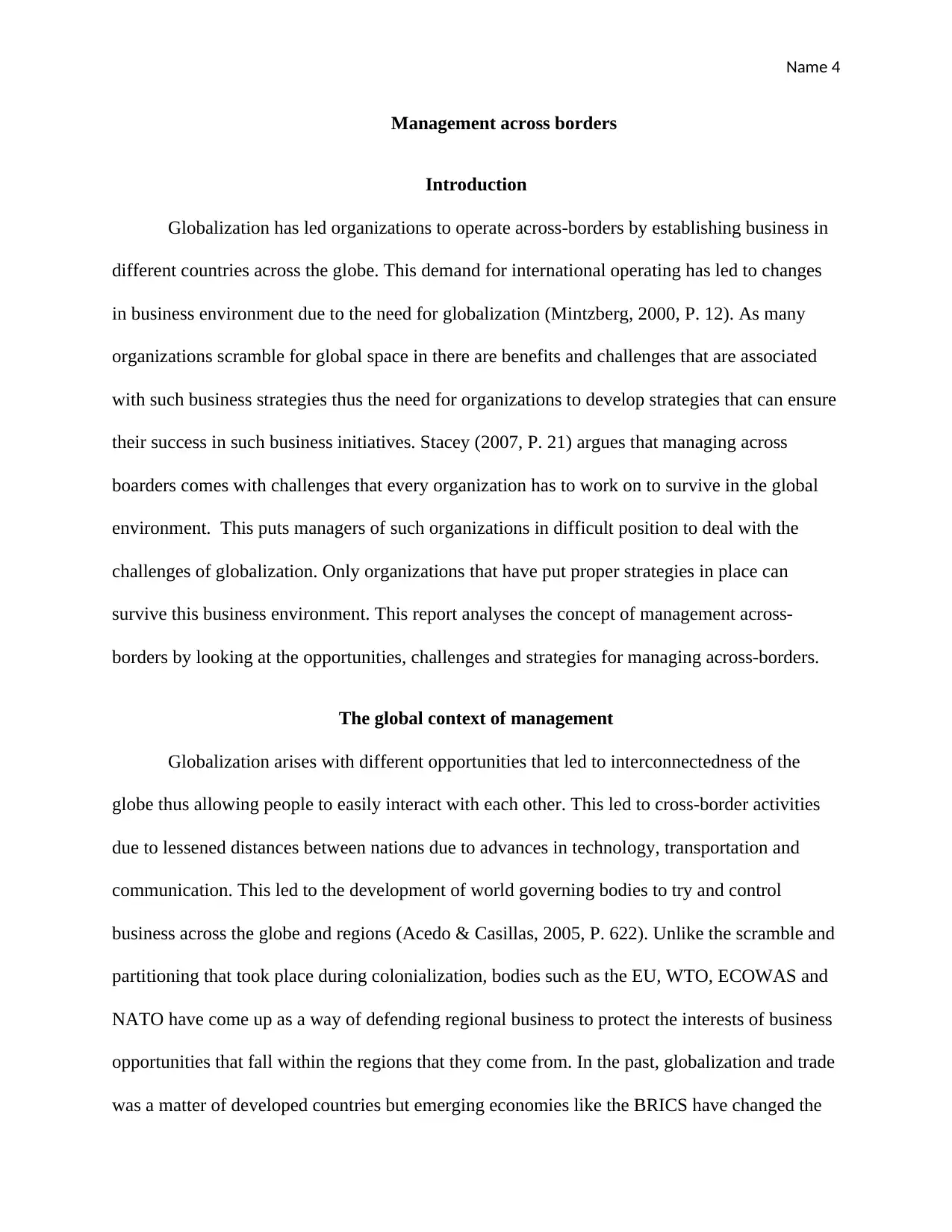
Name 4
Management across borders
Introduction
Globalization has led organizations to operate across-borders by establishing business in
different countries across the globe. This demand for international operating has led to changes
in business environment due to the need for globalization (Mintzberg, 2000, P. 12). As many
organizations scramble for global space in there are benefits and challenges that are associated
with such business strategies thus the need for organizations to develop strategies that can ensure
their success in such business initiatives. Stacey (2007, P. 21) argues that managing across
boarders comes with challenges that every organization has to work on to survive in the global
environment. This puts managers of such organizations in difficult position to deal with the
challenges of globalization. Only organizations that have put proper strategies in place can
survive this business environment. This report analyses the concept of management across-
borders by looking at the opportunities, challenges and strategies for managing across-borders.
The global context of management
Globalization arises with different opportunities that led to interconnectedness of the
globe thus allowing people to easily interact with each other. This led to cross-border activities
due to lessened distances between nations due to advances in technology, transportation and
communication. This led to the development of world governing bodies to try and control
business across the globe and regions (Acedo & Casillas, 2005, P. 622). Unlike the scramble and
partitioning that took place during colonialization, bodies such as the EU, WTO, ECOWAS and
NATO have come up as a way of defending regional business to protect the interests of business
opportunities that fall within the regions that they come from. In the past, globalization and trade
was a matter of developed countries but emerging economies like the BRICS have changed the
Management across borders
Introduction
Globalization has led organizations to operate across-borders by establishing business in
different countries across the globe. This demand for international operating has led to changes
in business environment due to the need for globalization (Mintzberg, 2000, P. 12). As many
organizations scramble for global space in there are benefits and challenges that are associated
with such business strategies thus the need for organizations to develop strategies that can ensure
their success in such business initiatives. Stacey (2007, P. 21) argues that managing across
boarders comes with challenges that every organization has to work on to survive in the global
environment. This puts managers of such organizations in difficult position to deal with the
challenges of globalization. Only organizations that have put proper strategies in place can
survive this business environment. This report analyses the concept of management across-
borders by looking at the opportunities, challenges and strategies for managing across-borders.
The global context of management
Globalization arises with different opportunities that led to interconnectedness of the
globe thus allowing people to easily interact with each other. This led to cross-border activities
due to lessened distances between nations due to advances in technology, transportation and
communication. This led to the development of world governing bodies to try and control
business across the globe and regions (Acedo & Casillas, 2005, P. 622). Unlike the scramble and
partitioning that took place during colonialization, bodies such as the EU, WTO, ECOWAS and
NATO have come up as a way of defending regional business to protect the interests of business
opportunities that fall within the regions that they come from. In the past, globalization and trade
was a matter of developed countries but emerging economies like the BRICS have changed the
Paraphrase This Document
Need a fresh take? Get an instant paraphrase of this document with our AI Paraphraser
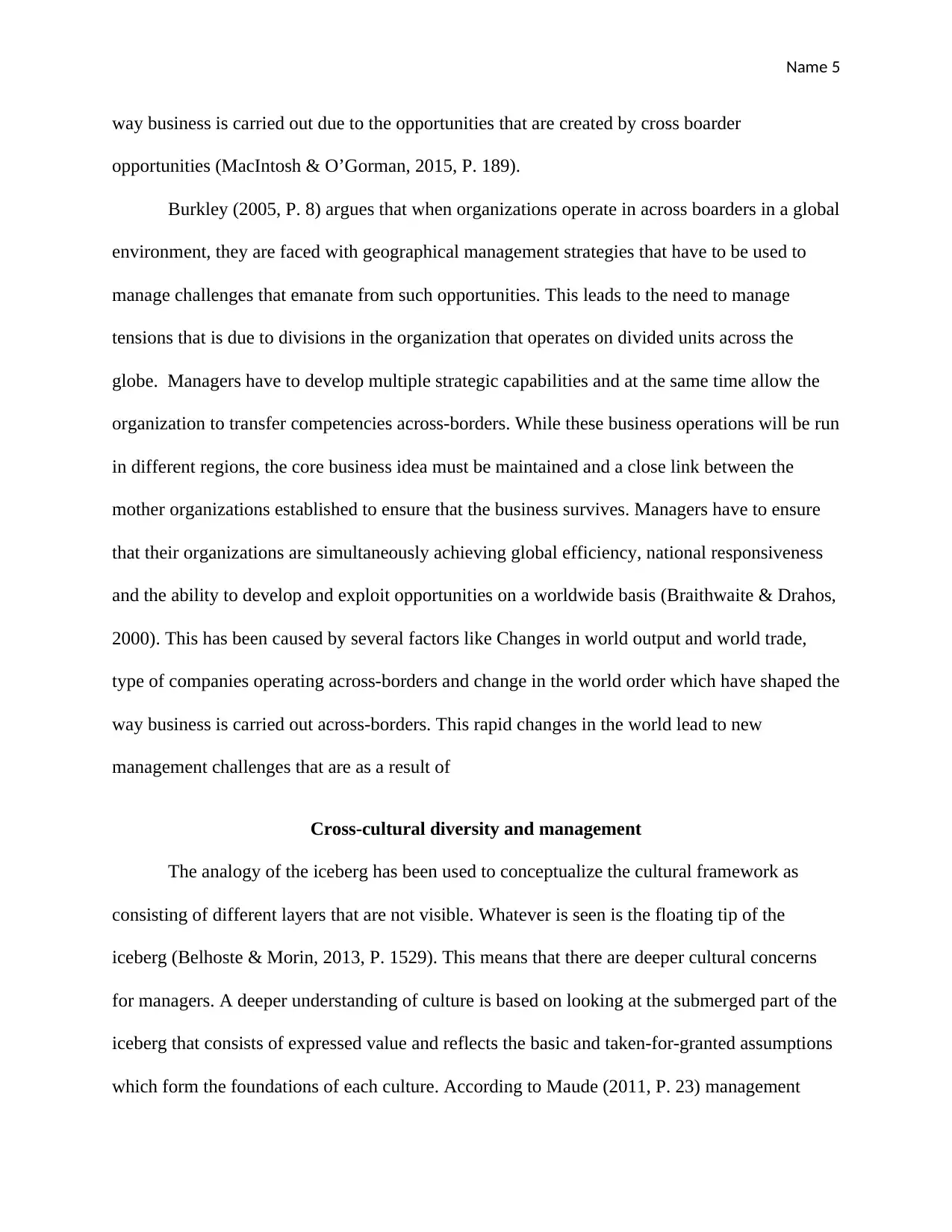
Name 5
way business is carried out due to the opportunities that are created by cross boarder
opportunities (MacIntosh & O’Gorman, 2015, P. 189).
Burkley (2005, P. 8) argues that when organizations operate in across boarders in a global
environment, they are faced with geographical management strategies that have to be used to
manage challenges that emanate from such opportunities. This leads to the need to manage
tensions that is due to divisions in the organization that operates on divided units across the
globe. Managers have to develop multiple strategic capabilities and at the same time allow the
organization to transfer competencies across-borders. While these business operations will be run
in different regions, the core business idea must be maintained and a close link between the
mother organizations established to ensure that the business survives. Managers have to ensure
that their organizations are simultaneously achieving global efficiency, national responsiveness
and the ability to develop and exploit opportunities on a worldwide basis (Braithwaite & Drahos,
2000). This has been caused by several factors like Changes in world output and world trade,
type of companies operating across-borders and change in the world order which have shaped the
way business is carried out across-borders. This rapid changes in the world lead to new
management challenges that are as a result of
Cross-cultural diversity and management
The analogy of the iceberg has been used to conceptualize the cultural framework as
consisting of different layers that are not visible. Whatever is seen is the floating tip of the
iceberg (Belhoste & Morin, 2013, P. 1529). This means that there are deeper cultural concerns
for managers. A deeper understanding of culture is based on looking at the submerged part of the
iceberg that consists of expressed value and reflects the basic and taken-for-granted assumptions
which form the foundations of each culture. According to Maude (2011, P. 23) management
way business is carried out due to the opportunities that are created by cross boarder
opportunities (MacIntosh & O’Gorman, 2015, P. 189).
Burkley (2005, P. 8) argues that when organizations operate in across boarders in a global
environment, they are faced with geographical management strategies that have to be used to
manage challenges that emanate from such opportunities. This leads to the need to manage
tensions that is due to divisions in the organization that operates on divided units across the
globe. Managers have to develop multiple strategic capabilities and at the same time allow the
organization to transfer competencies across-borders. While these business operations will be run
in different regions, the core business idea must be maintained and a close link between the
mother organizations established to ensure that the business survives. Managers have to ensure
that their organizations are simultaneously achieving global efficiency, national responsiveness
and the ability to develop and exploit opportunities on a worldwide basis (Braithwaite & Drahos,
2000). This has been caused by several factors like Changes in world output and world trade,
type of companies operating across-borders and change in the world order which have shaped the
way business is carried out across-borders. This rapid changes in the world lead to new
management challenges that are as a result of
Cross-cultural diversity and management
The analogy of the iceberg has been used to conceptualize the cultural framework as
consisting of different layers that are not visible. Whatever is seen is the floating tip of the
iceberg (Belhoste & Morin, 2013, P. 1529). This means that there are deeper cultural concerns
for managers. A deeper understanding of culture is based on looking at the submerged part of the
iceberg that consists of expressed value and reflects the basic and taken-for-granted assumptions
which form the foundations of each culture. According to Maude (2011, P. 23) management
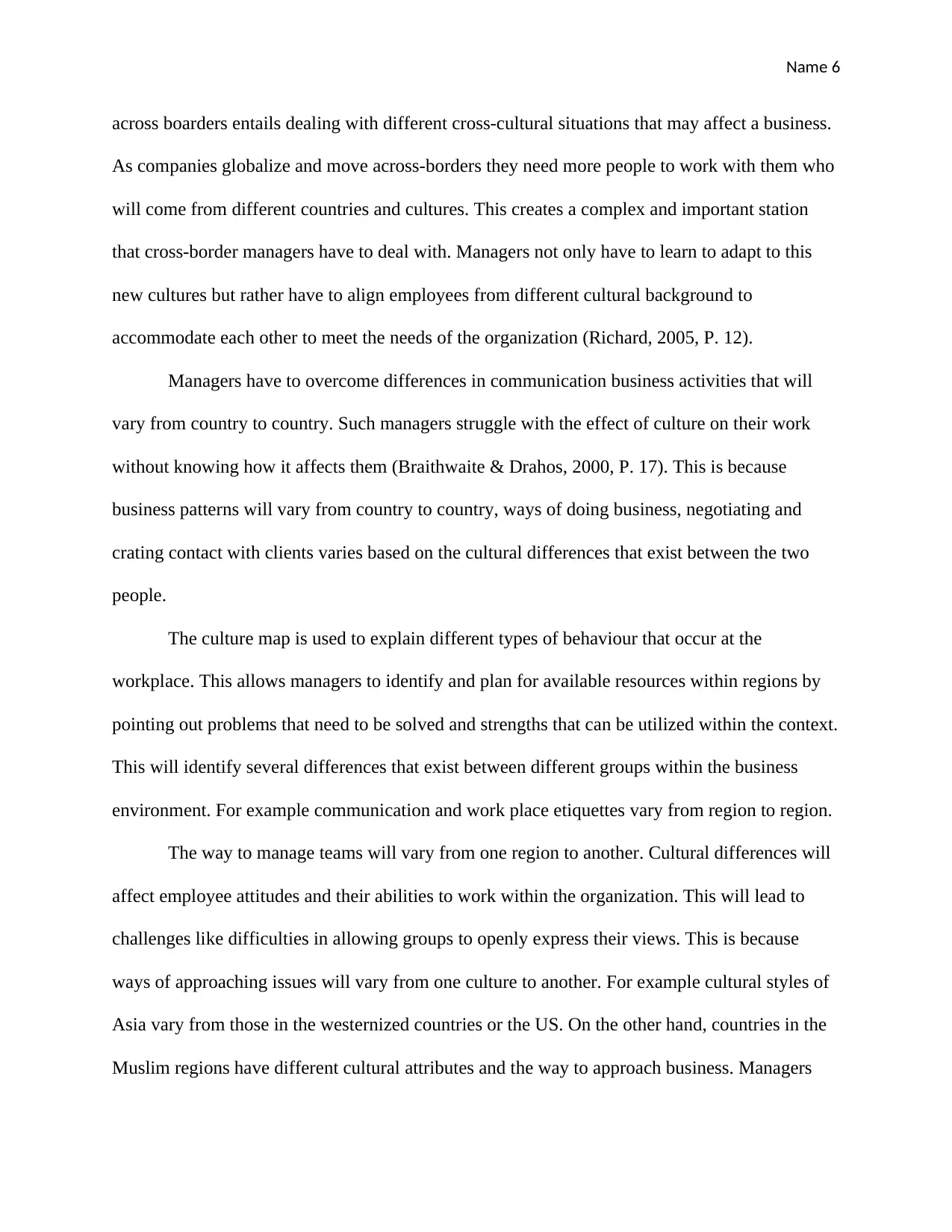
Name 6
across boarders entails dealing with different cross-cultural situations that may affect a business.
As companies globalize and move across-borders they need more people to work with them who
will come from different countries and cultures. This creates a complex and important station
that cross-border managers have to deal with. Managers not only have to learn to adapt to this
new cultures but rather have to align employees from different cultural background to
accommodate each other to meet the needs of the organization (Richard, 2005, P. 12).
Managers have to overcome differences in communication business activities that will
vary from country to country. Such managers struggle with the effect of culture on their work
without knowing how it affects them (Braithwaite & Drahos, 2000, P. 17). This is because
business patterns will vary from country to country, ways of doing business, negotiating and
crating contact with clients varies based on the cultural differences that exist between the two
people.
The culture map is used to explain different types of behaviour that occur at the
workplace. This allows managers to identify and plan for available resources within regions by
pointing out problems that need to be solved and strengths that can be utilized within the context.
This will identify several differences that exist between different groups within the business
environment. For example communication and work place etiquettes vary from region to region.
The way to manage teams will vary from one region to another. Cultural differences will
affect employee attitudes and their abilities to work within the organization. This will lead to
challenges like difficulties in allowing groups to openly express their views. This is because
ways of approaching issues will vary from one culture to another. For example cultural styles of
Asia vary from those in the westernized countries or the US. On the other hand, countries in the
Muslim regions have different cultural attributes and the way to approach business. Managers
across boarders entails dealing with different cross-cultural situations that may affect a business.
As companies globalize and move across-borders they need more people to work with them who
will come from different countries and cultures. This creates a complex and important station
that cross-border managers have to deal with. Managers not only have to learn to adapt to this
new cultures but rather have to align employees from different cultural background to
accommodate each other to meet the needs of the organization (Richard, 2005, P. 12).
Managers have to overcome differences in communication business activities that will
vary from country to country. Such managers struggle with the effect of culture on their work
without knowing how it affects them (Braithwaite & Drahos, 2000, P. 17). This is because
business patterns will vary from country to country, ways of doing business, negotiating and
crating contact with clients varies based on the cultural differences that exist between the two
people.
The culture map is used to explain different types of behaviour that occur at the
workplace. This allows managers to identify and plan for available resources within regions by
pointing out problems that need to be solved and strengths that can be utilized within the context.
This will identify several differences that exist between different groups within the business
environment. For example communication and work place etiquettes vary from region to region.
The way to manage teams will vary from one region to another. Cultural differences will
affect employee attitudes and their abilities to work within the organization. This will lead to
challenges like difficulties in allowing groups to openly express their views. This is because
ways of approaching issues will vary from one culture to another. For example cultural styles of
Asia vary from those in the westernized countries or the US. On the other hand, countries in the
Muslim regions have different cultural attributes and the way to approach business. Managers
⊘ This is a preview!⊘
Do you want full access?
Subscribe today to unlock all pages.

Trusted by 1+ million students worldwide
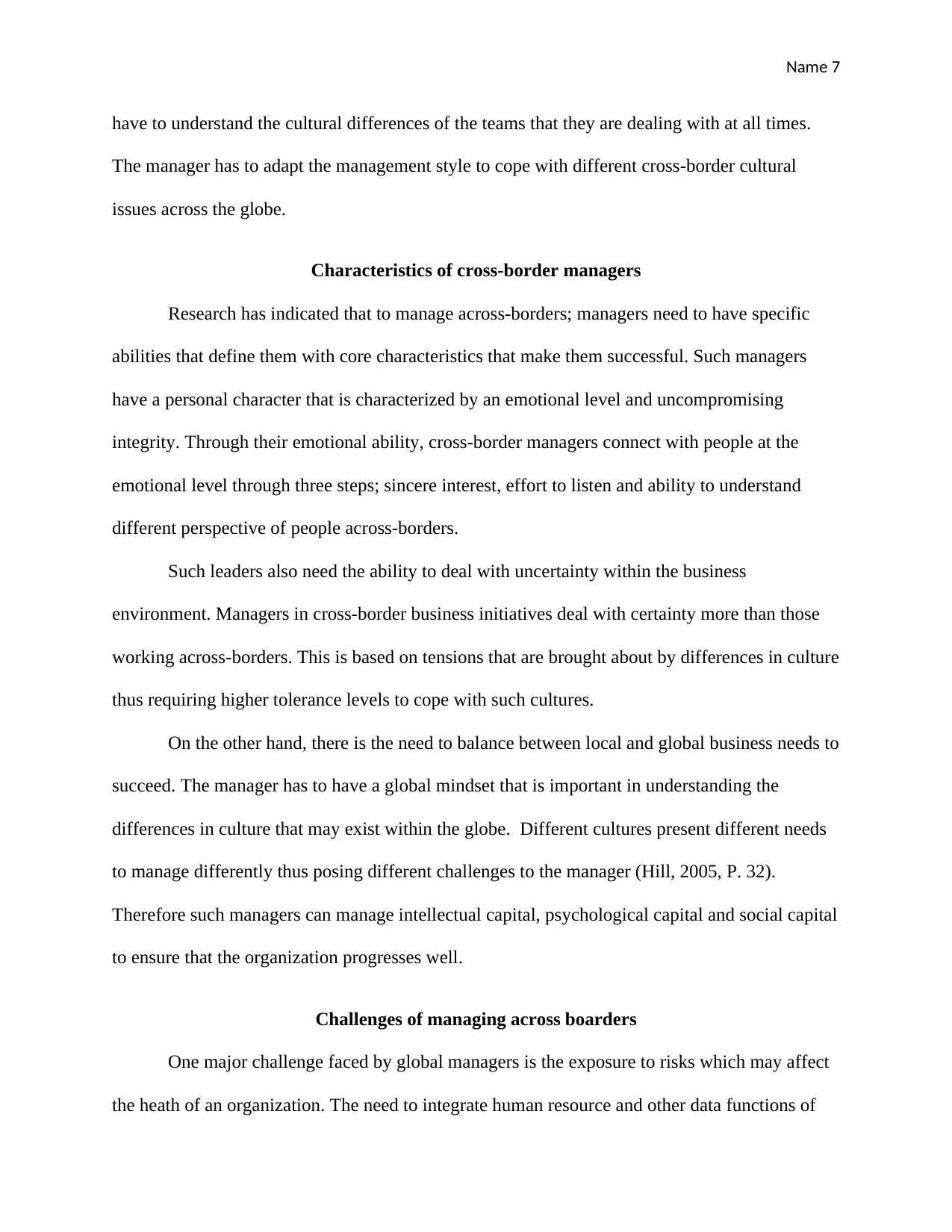
Name 7
have to understand the cultural differences of the teams that they are dealing with at all times.
The manager has to adapt the management style to cope with different cross-border cultural
issues across the globe.
Characteristics of cross-border managers
Research has indicated that to manage across-borders; managers need to have specific
abilities that define them with core characteristics that make them successful. Such managers
have a personal character that is characterized by an emotional level and uncompromising
integrity. Through their emotional ability, cross-border managers connect with people at the
emotional level through three steps; sincere interest, effort to listen and ability to understand
different perspective of people across-borders.
Such leaders also need the ability to deal with uncertainty within the business
environment. Managers in cross-border business initiatives deal with certainty more than those
working across-borders. This is based on tensions that are brought about by differences in culture
thus requiring higher tolerance levels to cope with such cultures.
On the other hand, there is the need to balance between local and global business needs to
succeed. The manager has to have a global mindset that is important in understanding the
differences in culture that may exist within the globe. Different cultures present different needs
to manage differently thus posing different challenges to the manager (Hill, 2005, P. 32).
Therefore such managers can manage intellectual capital, psychological capital and social capital
to ensure that the organization progresses well.
Challenges of managing across boarders
One major challenge faced by global managers is the exposure to risks which may affect
the heath of an organization. The need to integrate human resource and other data functions of
have to understand the cultural differences of the teams that they are dealing with at all times.
The manager has to adapt the management style to cope with different cross-border cultural
issues across the globe.
Characteristics of cross-border managers
Research has indicated that to manage across-borders; managers need to have specific
abilities that define them with core characteristics that make them successful. Such managers
have a personal character that is characterized by an emotional level and uncompromising
integrity. Through their emotional ability, cross-border managers connect with people at the
emotional level through three steps; sincere interest, effort to listen and ability to understand
different perspective of people across-borders.
Such leaders also need the ability to deal with uncertainty within the business
environment. Managers in cross-border business initiatives deal with certainty more than those
working across-borders. This is based on tensions that are brought about by differences in culture
thus requiring higher tolerance levels to cope with such cultures.
On the other hand, there is the need to balance between local and global business needs to
succeed. The manager has to have a global mindset that is important in understanding the
differences in culture that may exist within the globe. Different cultures present different needs
to manage differently thus posing different challenges to the manager (Hill, 2005, P. 32).
Therefore such managers can manage intellectual capital, psychological capital and social capital
to ensure that the organization progresses well.
Challenges of managing across boarders
One major challenge faced by global managers is the exposure to risks which may affect
the heath of an organization. The need to integrate human resource and other data functions of
Paraphrase This Document
Need a fresh take? Get an instant paraphrase of this document with our AI Paraphraser
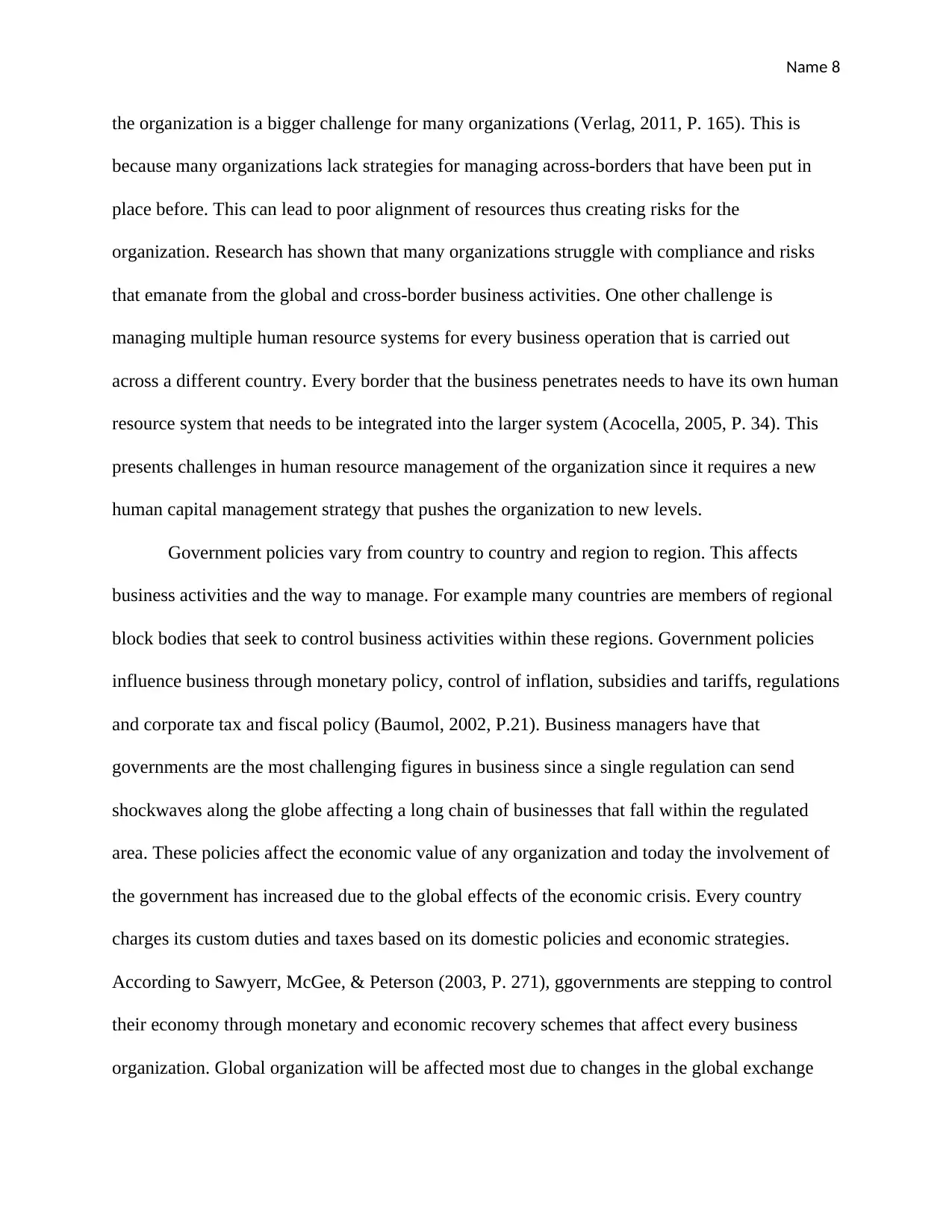
Name 8
the organization is a bigger challenge for many organizations (Verlag, 2011, P. 165). This is
because many organizations lack strategies for managing across-borders that have been put in
place before. This can lead to poor alignment of resources thus creating risks for the
organization. Research has shown that many organizations struggle with compliance and risks
that emanate from the global and cross-border business activities. One other challenge is
managing multiple human resource systems for every business operation that is carried out
across a different country. Every border that the business penetrates needs to have its own human
resource system that needs to be integrated into the larger system (Acocella, 2005, P. 34). This
presents challenges in human resource management of the organization since it requires a new
human capital management strategy that pushes the organization to new levels.
Government policies vary from country to country and region to region. This affects
business activities and the way to manage. For example many countries are members of regional
block bodies that seek to control business activities within these regions. Government policies
influence business through monetary policy, control of inflation, subsidies and tariffs, regulations
and corporate tax and fiscal policy (Baumol, 2002, P.21). Business managers have that
governments are the most challenging figures in business since a single regulation can send
shockwaves along the globe affecting a long chain of businesses that fall within the regulated
area. These policies affect the economic value of any organization and today the involvement of
the government has increased due to the global effects of the economic crisis. Every country
charges its custom duties and taxes based on its domestic policies and economic strategies.
According to Sawyerr, McGee, & Peterson (2003, P. 271), ggovernments are stepping to control
their economy through monetary and economic recovery schemes that affect every business
organization. Global organization will be affected most due to changes in the global exchange
the organization is a bigger challenge for many organizations (Verlag, 2011, P. 165). This is
because many organizations lack strategies for managing across-borders that have been put in
place before. This can lead to poor alignment of resources thus creating risks for the
organization. Research has shown that many organizations struggle with compliance and risks
that emanate from the global and cross-border business activities. One other challenge is
managing multiple human resource systems for every business operation that is carried out
across a different country. Every border that the business penetrates needs to have its own human
resource system that needs to be integrated into the larger system (Acocella, 2005, P. 34). This
presents challenges in human resource management of the organization since it requires a new
human capital management strategy that pushes the organization to new levels.
Government policies vary from country to country and region to region. This affects
business activities and the way to manage. For example many countries are members of regional
block bodies that seek to control business activities within these regions. Government policies
influence business through monetary policy, control of inflation, subsidies and tariffs, regulations
and corporate tax and fiscal policy (Baumol, 2002, P.21). Business managers have that
governments are the most challenging figures in business since a single regulation can send
shockwaves along the globe affecting a long chain of businesses that fall within the regulated
area. These policies affect the economic value of any organization and today the involvement of
the government has increased due to the global effects of the economic crisis. Every country
charges its custom duties and taxes based on its domestic policies and economic strategies.
According to Sawyerr, McGee, & Peterson (2003, P. 271), ggovernments are stepping to control
their economy through monetary and economic recovery schemes that affect every business
organization. Global organization will be affected most due to changes in the global exchange
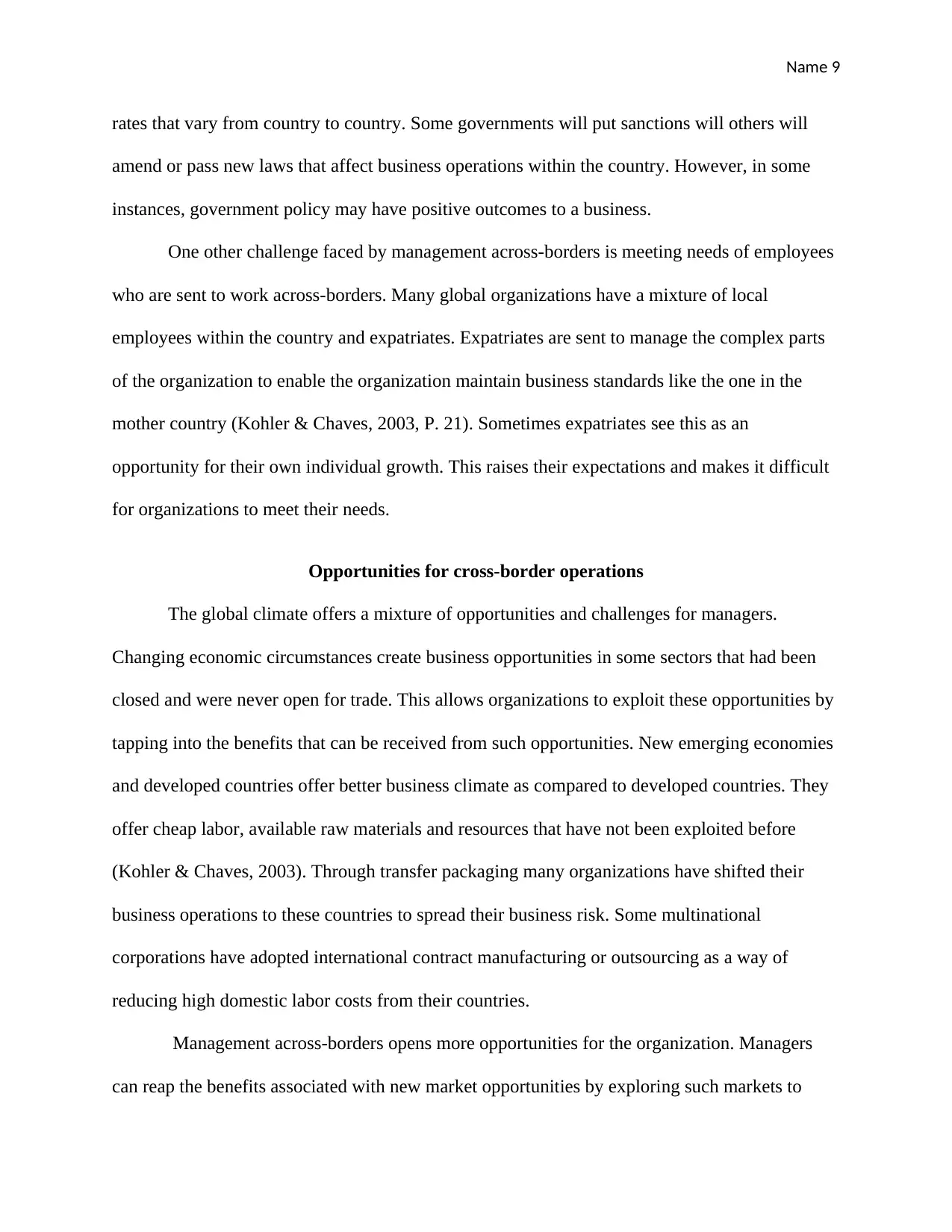
Name 9
rates that vary from country to country. Some governments will put sanctions will others will
amend or pass new laws that affect business operations within the country. However, in some
instances, government policy may have positive outcomes to a business.
One other challenge faced by management across-borders is meeting needs of employees
who are sent to work across-borders. Many global organizations have a mixture of local
employees within the country and expatriates. Expatriates are sent to manage the complex parts
of the organization to enable the organization maintain business standards like the one in the
mother country (Kohler & Chaves, 2003, P. 21). Sometimes expatriates see this as an
opportunity for their own individual growth. This raises their expectations and makes it difficult
for organizations to meet their needs.
Opportunities for cross-border operations
The global climate offers a mixture of opportunities and challenges for managers.
Changing economic circumstances create business opportunities in some sectors that had been
closed and were never open for trade. This allows organizations to exploit these opportunities by
tapping into the benefits that can be received from such opportunities. New emerging economies
and developed countries offer better business climate as compared to developed countries. They
offer cheap labor, available raw materials and resources that have not been exploited before
(Kohler & Chaves, 2003). Through transfer packaging many organizations have shifted their
business operations to these countries to spread their business risk. Some multinational
corporations have adopted international contract manufacturing or outsourcing as a way of
reducing high domestic labor costs from their countries.
Management across-borders opens more opportunities for the organization. Managers
can reap the benefits associated with new market opportunities by exploring such markets to
rates that vary from country to country. Some governments will put sanctions will others will
amend or pass new laws that affect business operations within the country. However, in some
instances, government policy may have positive outcomes to a business.
One other challenge faced by management across-borders is meeting needs of employees
who are sent to work across-borders. Many global organizations have a mixture of local
employees within the country and expatriates. Expatriates are sent to manage the complex parts
of the organization to enable the organization maintain business standards like the one in the
mother country (Kohler & Chaves, 2003, P. 21). Sometimes expatriates see this as an
opportunity for their own individual growth. This raises their expectations and makes it difficult
for organizations to meet their needs.
Opportunities for cross-border operations
The global climate offers a mixture of opportunities and challenges for managers.
Changing economic circumstances create business opportunities in some sectors that had been
closed and were never open for trade. This allows organizations to exploit these opportunities by
tapping into the benefits that can be received from such opportunities. New emerging economies
and developed countries offer better business climate as compared to developed countries. They
offer cheap labor, available raw materials and resources that have not been exploited before
(Kohler & Chaves, 2003). Through transfer packaging many organizations have shifted their
business operations to these countries to spread their business risk. Some multinational
corporations have adopted international contract manufacturing or outsourcing as a way of
reducing high domestic labor costs from their countries.
Management across-borders opens more opportunities for the organization. Managers
can reap the benefits associated with new market opportunities by exploring such markets to
⊘ This is a preview!⊘
Do you want full access?
Subscribe today to unlock all pages.

Trusted by 1+ million students worldwide
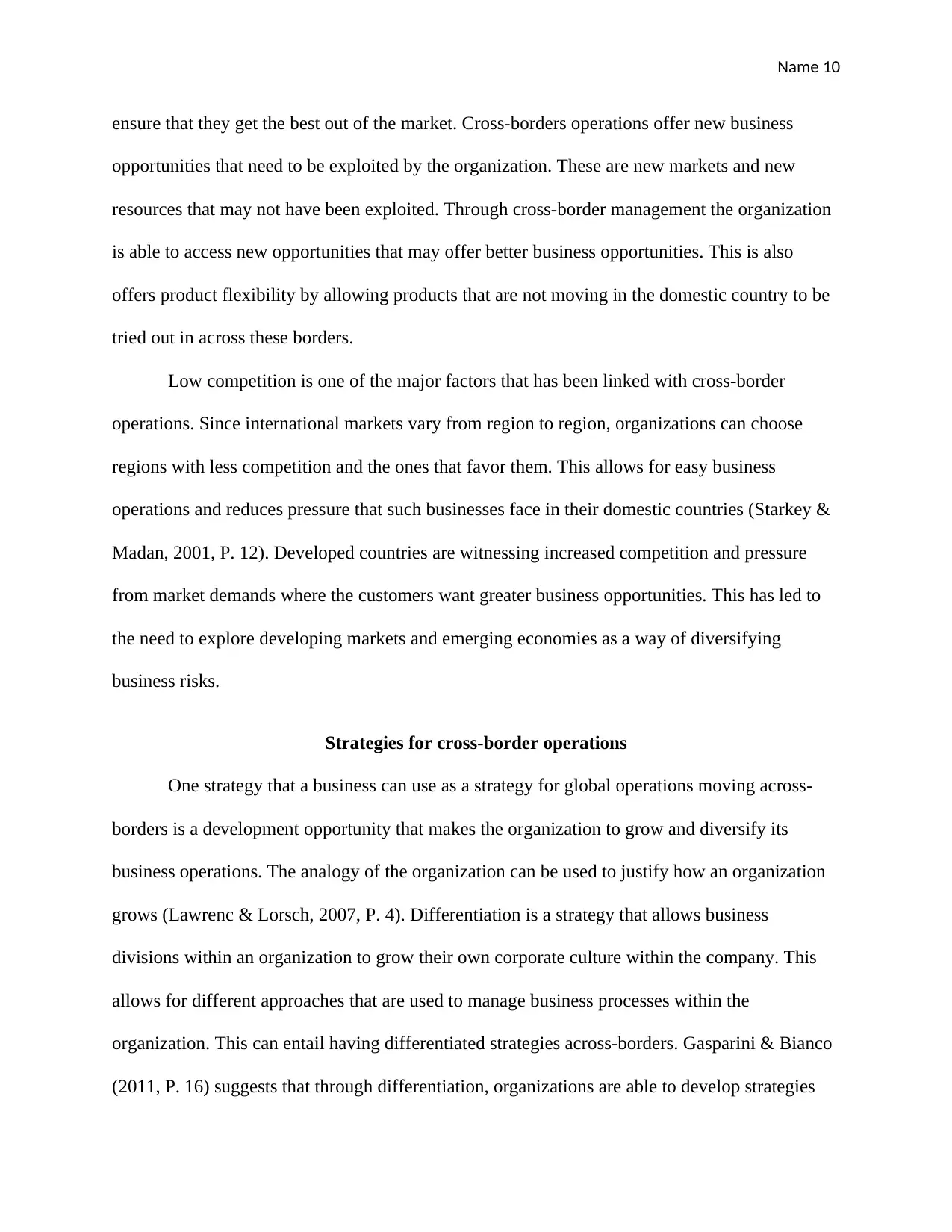
Name 10
ensure that they get the best out of the market. Cross-borders operations offer new business
opportunities that need to be exploited by the organization. These are new markets and new
resources that may not have been exploited. Through cross-border management the organization
is able to access new opportunities that may offer better business opportunities. This is also
offers product flexibility by allowing products that are not moving in the domestic country to be
tried out in across these borders.
Low competition is one of the major factors that has been linked with cross-border
operations. Since international markets vary from region to region, organizations can choose
regions with less competition and the ones that favor them. This allows for easy business
operations and reduces pressure that such businesses face in their domestic countries (Starkey &
Madan, 2001, P. 12). Developed countries are witnessing increased competition and pressure
from market demands where the customers want greater business opportunities. This has led to
the need to explore developing markets and emerging economies as a way of diversifying
business risks.
Strategies for cross-border operations
One strategy that a business can use as a strategy for global operations moving across-
borders is a development opportunity that makes the organization to grow and diversify its
business operations. The analogy of the organization can be used to justify how an organization
grows (Lawrenc & Lorsch, 2007, P. 4). Differentiation is a strategy that allows business
divisions within an organization to grow their own corporate culture within the company. This
allows for different approaches that are used to manage business processes within the
organization. This can entail having differentiated strategies across-borders. Gasparini & Bianco
(2011, P. 16) suggests that through differentiation, organizations are able to develop strategies
ensure that they get the best out of the market. Cross-borders operations offer new business
opportunities that need to be exploited by the organization. These are new markets and new
resources that may not have been exploited. Through cross-border management the organization
is able to access new opportunities that may offer better business opportunities. This is also
offers product flexibility by allowing products that are not moving in the domestic country to be
tried out in across these borders.
Low competition is one of the major factors that has been linked with cross-border
operations. Since international markets vary from region to region, organizations can choose
regions with less competition and the ones that favor them. This allows for easy business
operations and reduces pressure that such businesses face in their domestic countries (Starkey &
Madan, 2001, P. 12). Developed countries are witnessing increased competition and pressure
from market demands where the customers want greater business opportunities. This has led to
the need to explore developing markets and emerging economies as a way of diversifying
business risks.
Strategies for cross-border operations
One strategy that a business can use as a strategy for global operations moving across-
borders is a development opportunity that makes the organization to grow and diversify its
business operations. The analogy of the organization can be used to justify how an organization
grows (Lawrenc & Lorsch, 2007, P. 4). Differentiation is a strategy that allows business
divisions within an organization to grow their own corporate culture within the company. This
allows for different approaches that are used to manage business processes within the
organization. This can entail having differentiated strategies across-borders. Gasparini & Bianco
(2011, P. 16) suggests that through differentiation, organizations are able to develop strategies
Paraphrase This Document
Need a fresh take? Get an instant paraphrase of this document with our AI Paraphraser
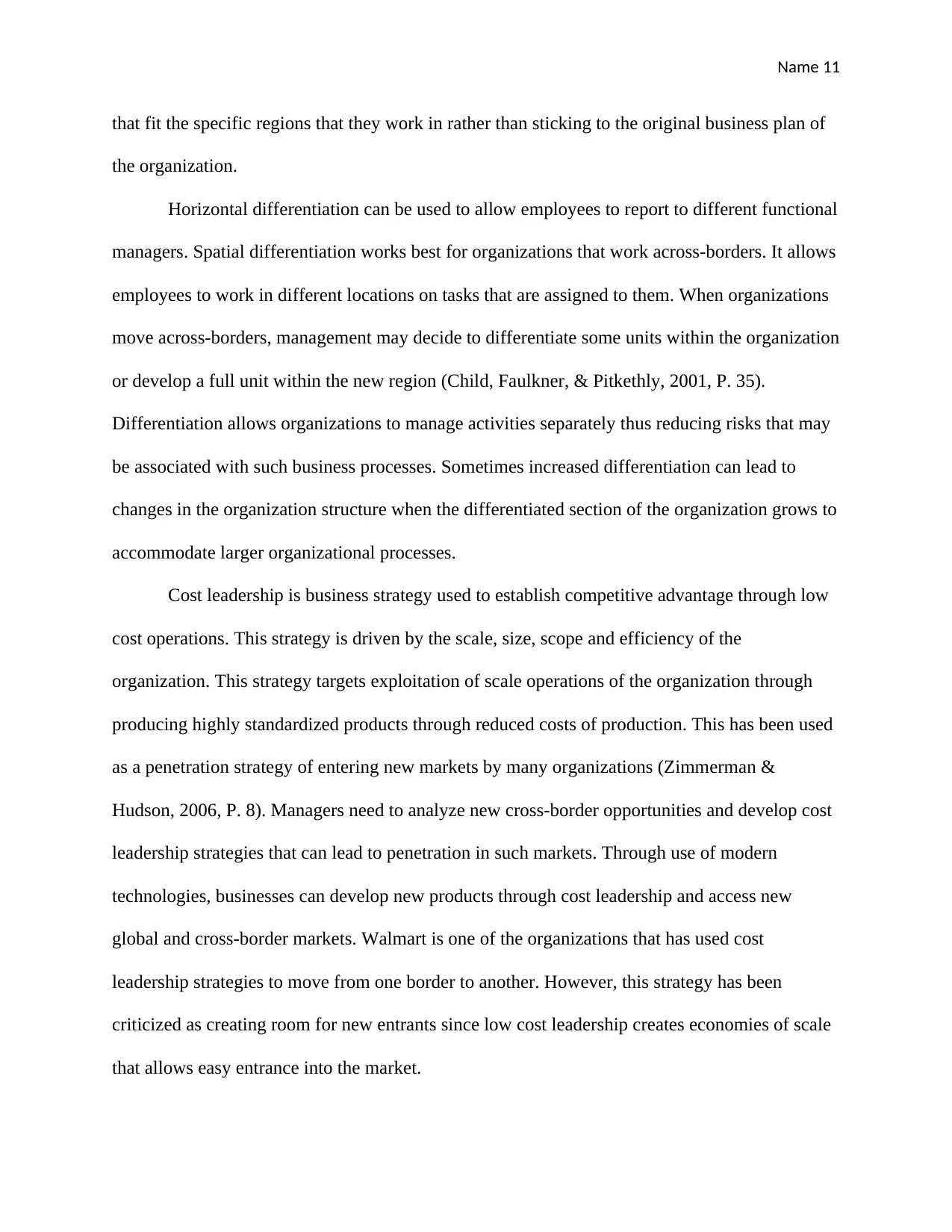
Name 11
that fit the specific regions that they work in rather than sticking to the original business plan of
the organization.
Horizontal differentiation can be used to allow employees to report to different functional
managers. Spatial differentiation works best for organizations that work across-borders. It allows
employees to work in different locations on tasks that are assigned to them. When organizations
move across-borders, management may decide to differentiate some units within the organization
or develop a full unit within the new region (Child, Faulkner, & Pitkethly, 2001, P. 35).
Differentiation allows organizations to manage activities separately thus reducing risks that may
be associated with such business processes. Sometimes increased differentiation can lead to
changes in the organization structure when the differentiated section of the organization grows to
accommodate larger organizational processes.
Cost leadership is business strategy used to establish competitive advantage through low
cost operations. This strategy is driven by the scale, size, scope and efficiency of the
organization. This strategy targets exploitation of scale operations of the organization through
producing highly standardized products through reduced costs of production. This has been used
as a penetration strategy of entering new markets by many organizations (Zimmerman &
Hudson, 2006, P. 8). Managers need to analyze new cross-border opportunities and develop cost
leadership strategies that can lead to penetration in such markets. Through use of modern
technologies, businesses can develop new products through cost leadership and access new
global and cross-border markets. Walmart is one of the organizations that has used cost
leadership strategies to move from one border to another. However, this strategy has been
criticized as creating room for new entrants since low cost leadership creates economies of scale
that allows easy entrance into the market.
that fit the specific regions that they work in rather than sticking to the original business plan of
the organization.
Horizontal differentiation can be used to allow employees to report to different functional
managers. Spatial differentiation works best for organizations that work across-borders. It allows
employees to work in different locations on tasks that are assigned to them. When organizations
move across-borders, management may decide to differentiate some units within the organization
or develop a full unit within the new region (Child, Faulkner, & Pitkethly, 2001, P. 35).
Differentiation allows organizations to manage activities separately thus reducing risks that may
be associated with such business processes. Sometimes increased differentiation can lead to
changes in the organization structure when the differentiated section of the organization grows to
accommodate larger organizational processes.
Cost leadership is business strategy used to establish competitive advantage through low
cost operations. This strategy is driven by the scale, size, scope and efficiency of the
organization. This strategy targets exploitation of scale operations of the organization through
producing highly standardized products through reduced costs of production. This has been used
as a penetration strategy of entering new markets by many organizations (Zimmerman &
Hudson, 2006, P. 8). Managers need to analyze new cross-border opportunities and develop cost
leadership strategies that can lead to penetration in such markets. Through use of modern
technologies, businesses can develop new products through cost leadership and access new
global and cross-border markets. Walmart is one of the organizations that has used cost
leadership strategies to move from one border to another. However, this strategy has been
criticized as creating room for new entrants since low cost leadership creates economies of scale
that allows easy entrance into the market.
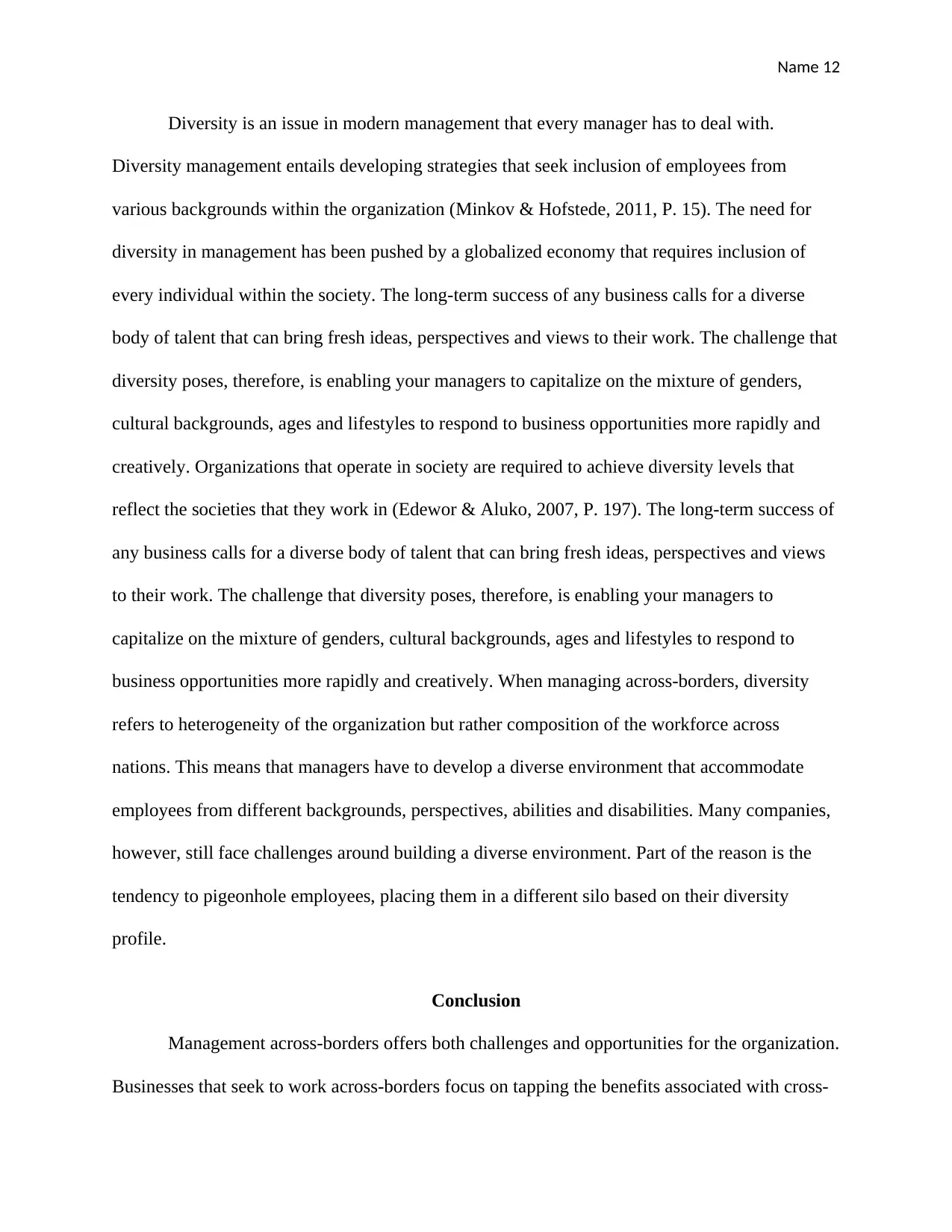
Name 12
Diversity is an issue in modern management that every manager has to deal with.
Diversity management entails developing strategies that seek inclusion of employees from
various backgrounds within the organization (Minkov & Hofstede, 2011, P. 15). The need for
diversity in management has been pushed by a globalized economy that requires inclusion of
every individual within the society. The long-term success of any business calls for a diverse
body of talent that can bring fresh ideas, perspectives and views to their work. The challenge that
diversity poses, therefore, is enabling your managers to capitalize on the mixture of genders,
cultural backgrounds, ages and lifestyles to respond to business opportunities more rapidly and
creatively. Organizations that operate in society are required to achieve diversity levels that
reflect the societies that they work in (Edewor & Aluko, 2007, P. 197). The long-term success of
any business calls for a diverse body of talent that can bring fresh ideas, perspectives and views
to their work. The challenge that diversity poses, therefore, is enabling your managers to
capitalize on the mixture of genders, cultural backgrounds, ages and lifestyles to respond to
business opportunities more rapidly and creatively. When managing across-borders, diversity
refers to heterogeneity of the organization but rather composition of the workforce across
nations. This means that managers have to develop a diverse environment that accommodate
employees from different backgrounds, perspectives, abilities and disabilities. Many companies,
however, still face challenges around building a diverse environment. Part of the reason is the
tendency to pigeonhole employees, placing them in a different silo based on their diversity
profile.
Conclusion
Management across-borders offers both challenges and opportunities for the organization.
Businesses that seek to work across-borders focus on tapping the benefits associated with cross-
Diversity is an issue in modern management that every manager has to deal with.
Diversity management entails developing strategies that seek inclusion of employees from
various backgrounds within the organization (Minkov & Hofstede, 2011, P. 15). The need for
diversity in management has been pushed by a globalized economy that requires inclusion of
every individual within the society. The long-term success of any business calls for a diverse
body of talent that can bring fresh ideas, perspectives and views to their work. The challenge that
diversity poses, therefore, is enabling your managers to capitalize on the mixture of genders,
cultural backgrounds, ages and lifestyles to respond to business opportunities more rapidly and
creatively. Organizations that operate in society are required to achieve diversity levels that
reflect the societies that they work in (Edewor & Aluko, 2007, P. 197). The long-term success of
any business calls for a diverse body of talent that can bring fresh ideas, perspectives and views
to their work. The challenge that diversity poses, therefore, is enabling your managers to
capitalize on the mixture of genders, cultural backgrounds, ages and lifestyles to respond to
business opportunities more rapidly and creatively. When managing across-borders, diversity
refers to heterogeneity of the organization but rather composition of the workforce across
nations. This means that managers have to develop a diverse environment that accommodate
employees from different backgrounds, perspectives, abilities and disabilities. Many companies,
however, still face challenges around building a diverse environment. Part of the reason is the
tendency to pigeonhole employees, placing them in a different silo based on their diversity
profile.
Conclusion
Management across-borders offers both challenges and opportunities for the organization.
Businesses that seek to work across-borders focus on tapping the benefits associated with cross-
⊘ This is a preview!⊘
Do you want full access?
Subscribe today to unlock all pages.

Trusted by 1+ million students worldwide
1 out of 15
Related Documents
Your All-in-One AI-Powered Toolkit for Academic Success.
+13062052269
info@desklib.com
Available 24*7 on WhatsApp / Email
![[object Object]](/_next/static/media/star-bottom.7253800d.svg)
Unlock your academic potential
Copyright © 2020–2025 A2Z Services. All Rights Reserved. Developed and managed by ZUCOL.





